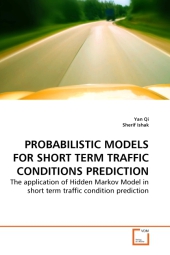 Neuerscheinungen 2010Stand: 2020-01-07 |
Schnellsuche
ISBN/Stichwort/Autor
|
Herderstraße 10
10625 Berlin
Tel.: 030 315 714 16
Fax 030 315 714 14
info@buchspektrum.de |

Sherif Ishak, Yan Qi
(Beteiligte)
PROBABILISTIC MODELS FOR SHORT TERM TRAFFIC CONDITIONS PREDICTION
The application of Hidden Markov Model in short term traffic condition prediction
2010. 172 S. 220 mm
Verlag/Jahr: VDM VERLAG DR. MÜLLER 2010
ISBN: 3-639-26493-2 (3639264932)
Neue ISBN: 978-3-639-26493-7 (9783639264937)
Preis und Lieferzeit: Bitte klicken
Given the dynamic nature of freeway traffic, this study proposed two stochastic model approaches, Hidden Markov Model (HMM) and One-Step Stochastic Model, for short-term traffic prediction during peak periods. The HMM approach defines traffic states in a two dimensional space using both first and second order statistics of traffic parameters. For a sequence of traffic speed observations, the HMMs estimated the most likely corresponding traffic states sequence. The one-step stochastic model uses traffic speed as the traffic condition indicator. The cumulative negative/positive transition probabilities and expected values were derived from the transition probabilities. The conditional expected value of the most likely transition trend is taken as the predicted speed. Relatively small prediction errors were obtained for both approaches, and the model performance was not remarkably affected by location, travel direction, and peak period time. It is concluded that the stochastic properties are the characteristics of freeway traffic by nature and the stochastic approaches are appropriate for short-term traffic condition prediction during peak periods.


